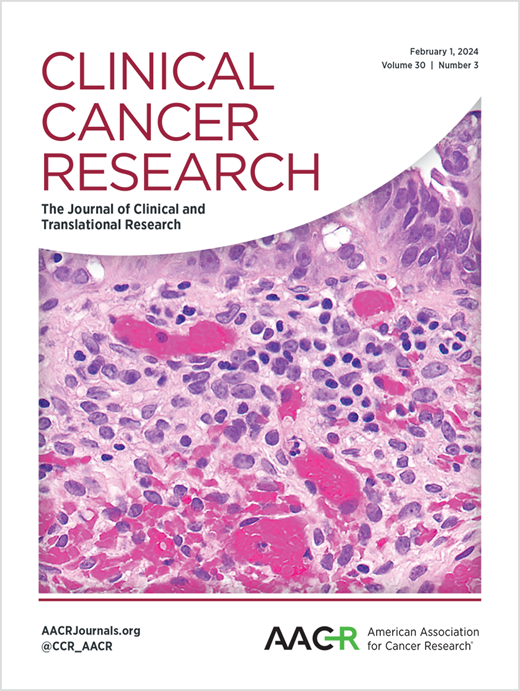使用实体肿瘤ctDNA反应评估标准(ctDNA- recist)研究早期ctDNA动力学对转移性胰腺癌预后的影响。
IF 10.2
1区 医学
Q1 ONCOLOGY
引用次数: 0
摘要
全身治疗期间ctDNA水平的变化可能预测转移性胰腺导管腺癌(PDAC)患者的治疗效果,但定量反应标准尚未建立。本研究评估了我们最近提出的实体肿瘤ctDNA应答评价标准(ctDNA- recist)。材料与方法收集220例接受一线姑息性化疗的转移性PDAC患者在治疗前、第二个治疗周期前和第一次ct评估时的血液样本。采用数字液滴PCR (ddPCR)和HOXA9甲基化法检测血浆ctDNA水平。ctDNA应答根据ctDNA- recist确定,并与总生存期(OS)相关。结果71%的患者治疗前sctdna阳性,与OS相关(HR=1.61, 95% CI 1.19 ~ 2.19, p=0.002)。在ctDNA阳性患者中,第二治疗周期前ctDNA最大缓解(MR) (n=41)和ctDNA疾病控制(DC) (n=107)比ctDNA进展性疾病(PD) (n=5)有更长的生存期(中位生存期:MR 11.9个月,DC 7.2个月,PD 3.6个月;p=0.002)。在Cox回归中,ctDNA DC (HR=1.55, 95% CI 1.07-2.26, p=0.021)和ctDNA PD (HR=4.50, 1.74-11.6, p=0.002)比ctDNA mr显示更短的OS,同样适用于第二个治疗周期的ctDNA反应(p<0.001)和治疗开始时的第一次ct评估(p<0.001)。ctDNA-RECIST应用于液体活检有可能早期评估转移性PDAC患者的治疗效果,为指导早期临床决策提供了一种新颖的微创方法。未来的研究应该前瞻性地验证ctDNA-RECIST,最好是在随机对照试验中。本文章由计算机程序翻译,如有差异,请以英文原文为准。
The prognostic impact of early ctDNA kinetics in metastatic pancreatic cancer using the ctDNA Response Evaluation Criteria in Solid Tumors (ctDNA-RECIST).
INTRODUCTION
Changes in ctDNA levels during systemic treatment may predict treatment efficacy in patients with metastatic pancreatic ductal adenocarcinoma (PDAC), but quantitative response criteria are not yet established. This study evaluates our recently proposed ctDNA Response Evaluation Criteria in Solid Tumors (ctDNA-RECIST).
MATERIAL AND METHOD
Blood samples were collected pre-treatment, before the second treatment cycle, and at time of the first CT-evaluation from 220 patients with metastatic PDAC receiving first line palliative chemotherapy. Plasma ctDNA levels were measured using digital droplet PCR (ddPCR) with HOXA9 methylation assays. ctDNA response was determined according to ctDNA-RECIST and correlated with overall survival (OS).
RESULTS
ctDNA was positive pre-treatment in 71% of the patients, and was related with OS (HR=1.61, 95% CI 1.19-2.19, p=0.002). Among ctDNA-positive patients, ctDNA Maximal Response (MR) (n=41) and ctDNA Disease Control (DC) (n=107) before the second treatment cycle had longer OS compared with ctDNA Progressive Disease (PD) (n=5) (median OS: MR 11.9 months, DC 7.2 months, PD 3.6 months; p=0.002). In Cox regression ctDNA DC (HR=1.55, 95% CI 1.07-2.26, p=0.021) and ctDNA PD (HR=4.50, 1.74-11.6, p=0.002) showed shorter OS compared to ctDNA MR. The same applied to ctDNA response from the second treatment cycle (p<0.001) and at time of the first CT-evaluation assessed from treatment start (p<0.001) Conclusion: ctDNA-RECIST applied to liquid biopsies holds potential for early evaluation of treatment benefit in patients with metastatic PDAC, offering a novel, minimally invasive method to guide early clinical decision making. Future studies should validate ctDNA-RECIST prospectively, preferably in randomised controlled trials.
求助全文
通过发布文献求助,成功后即可免费获取论文全文。
去求助
来源期刊

Clinical Cancer Research
医学-肿瘤学
CiteScore
20.10
自引率
1.70%
发文量
1207
审稿时长
2.1 months
期刊介绍:
Clinical Cancer Research is a journal focusing on groundbreaking research in cancer, specifically in the areas where the laboratory and the clinic intersect. Our primary interest lies in clinical trials that investigate novel treatments, accompanied by research on pharmacology, molecular alterations, and biomarkers that can predict response or resistance to these treatments. Furthermore, we prioritize laboratory and animal studies that explore new drugs and targeted agents with the potential to advance to clinical trials. We also encourage research on targetable mechanisms of cancer development, progression, and metastasis.
 求助内容:
求助内容: 应助结果提醒方式:
应助结果提醒方式:


